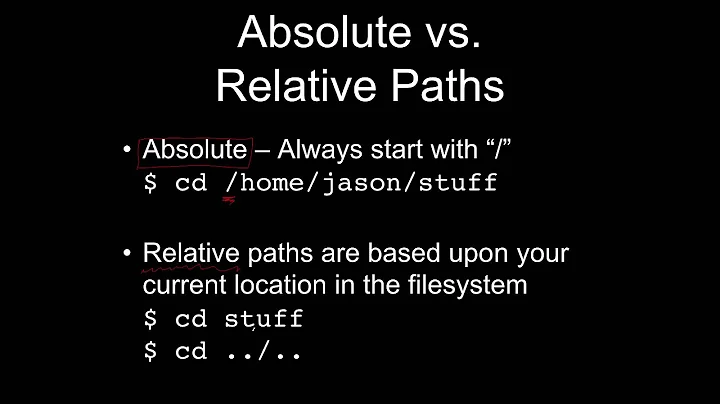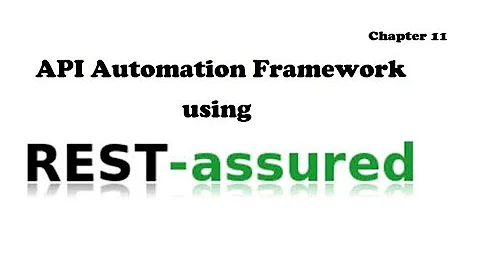Create new URI from Base URI and Relative Path - slash makes a difference?
Solution 1
Why does a slash make difference when using new URI(baseUri, relativePath)?
Well, that's what happens on the web normally.
For example, suppose I'm looking at http://foo.com/some/file1.html and there's a link to file2.html - that link goes to http://foo.com/some/file2.html, right? Not http://foo.com/some/file1.html/file2.html.
More specifically though, this follows section 5.2.3 of RFC 3986.
5.2.3. Merge Paths
The pseudocode above refers to a "merge" routine for merging a relative-path reference with the path of the base URI. This is accomplished as follows:
If the base URI has a defined authority component and an empty path, then return a string consisting of "/" concatenated with the reference's path; otherwise,
return a string consisting of the reference's path component appended to all but the last segment of the base URI's path (i.e., excluding any characters after the right-most "/" in the base URI path, or excluding the entire base URI path if it does not contain any "/" characters).
Solution 2
I've been playing around with the Uri constructor with the overload new Uri(baseUri, relativePath). Perhaps others may find the results useful. Here's the output from the test application I wrote:
A) Base Address is domain only
==============================
NO trailing slash on base address, NO leading slash on relative path:
http://foo.com + relative1/relative2 :
http://foo.com/relative1/relative2
NO trailing slash on base address, relative path HAS leading slash:
http://foo.com + /relative1/relative2 :
http://foo.com/relative1/relative2
Base address HAS trailing slash, NO leading slash on relative path:
http://foo.com/ + relative1/relative2 :
http://foo.com/relative1/relative2
Base address HAS trailing slash, relative path HAS leading slash:
http://foo.com/ + /relative1/relative2 :
http://foo.com/relative1/relative2
B) Base Address includes path
=============================
NO trailing slash on base address, NO leading slash on relative path:
http://foo.com/base1/base2 + relative1/relative2 :
http://foo.com/base1/relative1/relative2
(removed base2 segment)
NO trailing slash on base address, relative path HAS leading slash:
http://foo.com/base1/base2 + /relative1/relative2 :
http://foo.com/relative1/relative2
(removed base1 and base2 segments)
Base address HAS trailing slash, NO leading slash on relative path:
http://foo.com/base1/base2/ + relative1/relative2 :
http://foo.com/base1/base2/relative1/relative2
(has all segments)
Base address HAS trailing slash, relative path HAS leading slash:
http://foo.com/base1/base2/ + /relative1/relative2 :
http://foo.com/relative1/relative2
(removed base1 and base2 segments)
Solution 3
I was looking for the same, and arrived at the following solution:
var badBase = new Uri("http://amee/noTrailingSlash");
var goodBase = new Uri("http://amee/trailingSlash/");
var f = "relPath";
string badBaseUrl = Path.Combine(badBase,f);
string goodBaseUrl = Path.Combine(goodBase,f);
new Uri(badBaseUrl); //----> (http://amee/trailingSlash/relPath)
new Uri(goodBaseUrl); //---> (http://amee/trailingSlash/relPath)
Related videos on Youtube
Comments
-
user2864740 over 1 year
Why does a slash make difference when using new URI(baseUri, relativePath)?
This constructor creates a Uri instance by combining the baseUri and the relativeUri ..
And, how can can a relative path be appended safely/consistently to a URI?
var badBase = new Uri("http://amee/noTrailingSlash"); var goodBase = new Uri("http://amee/trailingSlash/"); var f = "relPath"; new Uri(badBase, f) // BAD -> http://amee/relPath new Uri(goodBase, f) // GOOD -> http://amee/trailingSlash/relPathThe desired output is "good" case, even when the initial URI does not have a trailing slash.
-
user2864740 about 10 yearsI was just found your other answer too. Thanks for including the RFC link, as that explicitly answers my "why" question.
-
Jon Skeet about 10 years@user2864740: Thanks for adding the appropriate quote :)
-
user2864740 about 10 yearsI don't suppose there is an alternate
URI(eitherOrSlash) -> URI(withSlash)without going theURI->String->URI route? -
Jon Skeet about 10 years@user2864740: Not that I'm aware of, I'm afraid :(
-
Steztric over 3 yearsI would never have guessed the behaviour of
new Uri()with a base address that has a path. This answer saved me a lot of hair.











